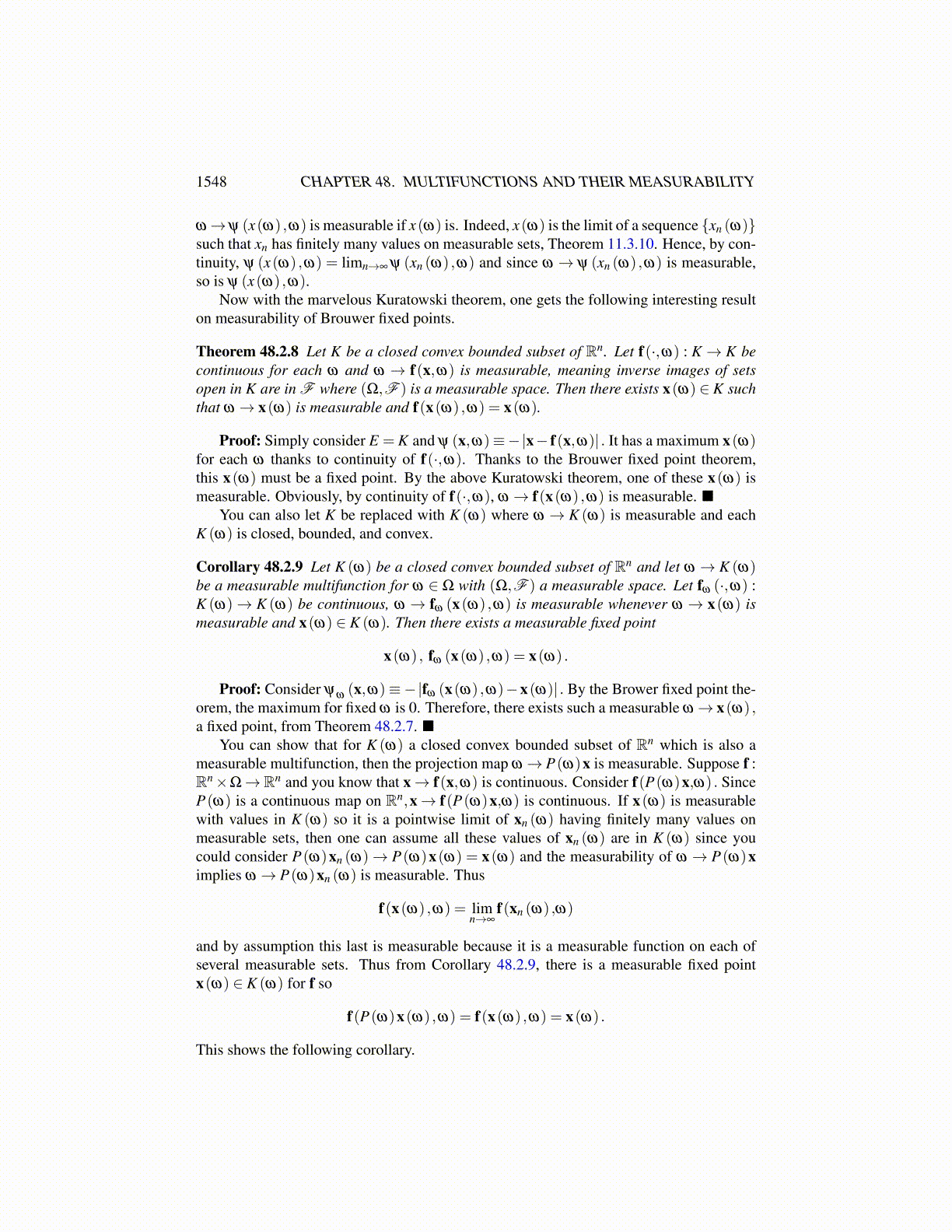
1548 CHAPTER 48. MULTIFUNCTIONS AND THEIR MEASURABILITY
Corollary 48.2.5 Let K be a closed convex bounded subset of Rn. Let f(·,ω) : K → Kbe continuous for each ω and ω → f(x,ω) is measurable, meaning inverse images of setsopen in K are in F where (Ω,F ) is a measurable space. Then there exists x(ω) ∈ K suchthat ω → x(ω) is measurable and f(x(ω) ,ω) = x(ω).
Proof: Let S be a large simplex containing K and let P be the projection map ontoK. Consider g(x,ω)≡ f(P(x) ,ω) . Then g satisfies the necessary conditions for Theorem48.2.4 and so there exists x(ω) ∈ S such that ω → x(ω) is measurable and g(x(ω) ,ω) =x(ω) . But this says x(ω) ∈ K and so g(x(ω) ,ω) = f(x(ω) ,ω).
Much shorter proof
The above gives a proof of a measurable fixed point as part of a proof of the Brouwerfixed point theorem directly but it is a lot easier if you simply begin with the existence ofthe Brouwer fixed point and show it is measurable. We sent the above to be consideredfor publication and the referee pointed this out. I totally missed it because I had forgottenabout the Kuratowski selection theorem. The functions f : Ω×E → R in which f (·,ω) iscontinuous are called Caratheodory functions.
Kuratowski [82] which is presented next. It is Theorem 11.1.11 in this book. I will givean alternate proof which comes from the measurable selection result of Corollary 48.2.3.
Theorem 48.2.6 Let E be a compact metric space and let (Ω,F ) be a measure space.Suppose ψ : E×Ω→R has the property that x→ψ (x,ω) is continuous and ω→ψ (x,ω)is measurable. Then there exists a measurable function, f having values in E such that
ψ ( f (ω) ,ω) = maxx∈E
ψ (x,ω) .
Furthermore, ω → ψ ( f (ω) ,ω) is measurable.
Proof: Let C = {ei}∞
i=1 be a countable dense subset of E. For example, take the unionof 1/2n nets for all n. Let Cn ≡ {e1, ...,en} . Let ω → fn (ω) be measurable and satisfy
ψ ( fn (ω) ,ω) = supx∈Cn
ψ (x,ω)
This is easily done as follows. Let Bk ≡{
ω : ψ (ek,ω)≥ ψ (e j,ω) for all j ̸= k}. Then
let A1 ≡ B1 and if A1, ...,Ak have been chosen, let Ak+1 ≡ Bk+1 \(∪k
j=1Bk
). Thus each Ak
is measurable and you let fn (ω) ≡ ek for ω ∈ Ak. Using Corollary 48.2.3, there is mea-surable f (ω) and a subsequence n(ω) such that fn(ω) (ω)→ f (ω) . Then by continuity,ψ ( f (ω) ,ω) = limn(ω)→∞ ψ
(fn(ω) (ω) ,ω
)and this is an increasing sequence in this limit.
Hence ψ ( f (ω) ,ω)≥ supx∈Cnψ (x,ω) for each n and so ψ ( f (ω) ,ω)≥ supx∈C ψ (x,ω) =
supx∈E ψ (x,ω). Since f is measurable, it is the limit of a sequence { fn (ω)} such that fnhas finitely many values occuring on measurable sets, Theorem 11.3.10. Hence, by con-tinuity, ψ ( f (ω) ,ω) = limn→∞ ψ ( fn (ω) ,ω) and since ω → ψ ( fn (ω) ,ω) is measurable,so is ψ ( f (ω) ,ω).
One can generalize fairly easily. It is the same argument but carrying around more ω .